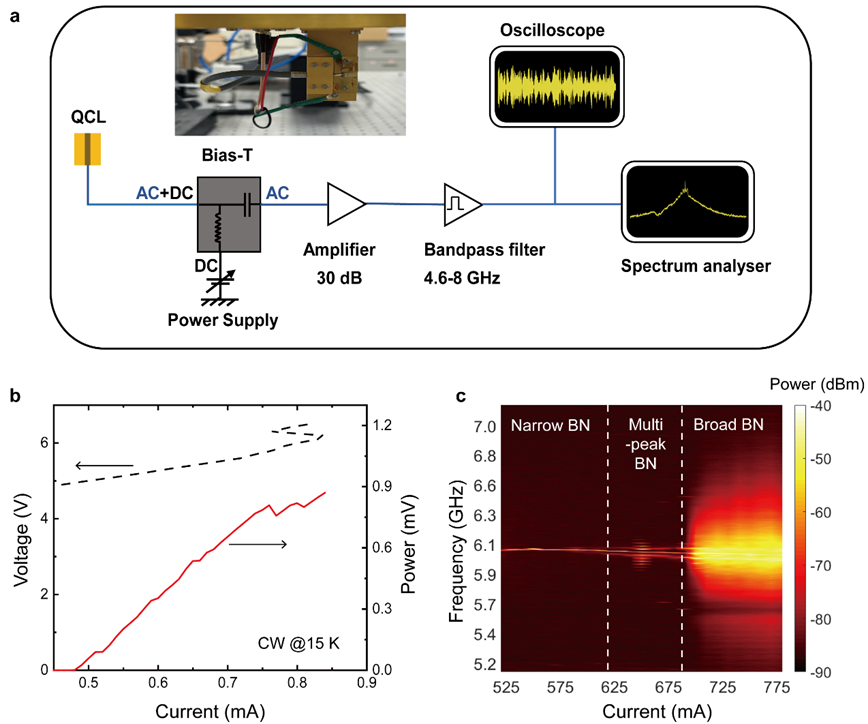Terahertz semiconductor laser chaos
Date:19-11-2025 | 【Print】 【close】
Recently, the terahertz (THz) photonics group led by Prof. Hua Li at the Shanghai Institute of Microsystem and Information Technology, Chinese Academy of Sciences, collaborating with Prof. Heping Zeng at the East China Normal University and Prof. Lorenzo Luigi Columbo at the Politecnico di Torino, made progress in the terahertz semiconductor laser chaos. The research work was published in Nature Communications on November 13, 2025 (Binbin Liu, Carlo Silvestri, Kang Zhou, Xuhong Ma, Shumin Wu, Ziping Li, Wenjian Wan, Zhenzhen Zhang, Ying Zhang, Junsong Peng, Heping Zeng, Cheng Wang, Massimo Brambilla, Lorenzo Luigi Columbo, and Hua Li, Terahertz semiconductor laser chaos, Nature Communications 2025, 16, 9985).
Chaos characterized by aperiodic deterministic dynamics in nonlinear systems has played a pivotal role in interpreting and controlling various ordered and disordered behaviors since its discovery (Journal of Atmospheric Sciences 1963, 20, 130–141). However, generating chaos in terahertz (THz) semiconductor lasers is challenging due to the scarcity of effective THz light sources and high-speed detectors. The semiconductor-based quantum cascade laser (QCL) (Nature 2002, 417, 156–159) is one of the most suitable sources for chaos generation in mid-infrared and THz wavelengths.
In this work, the research group demonstrated the chaos generation in a free-running multimode THz QCL emitting around 4.2 THz, without any external perturbations. Figure 1a shows the experimental setup employed for the chaos characterization of THz QCLs. The inset of Figure 1a shows an optical photo of the THz QCL mounted with a microstrip line and high-speed cable for high-frequency extractions. Figure1b demonstrates the light–current–voltage (L-I-V) characteristics of the THz QCL measured in continuous wave (CW) mode at a heat sink temperature of 15 K. In Figure 1c, the inter-mode beatnote (BN) of the THz QCL is measured and analysed while changing the bias current. Single narrow BN, multi-peak BN, and broad BN spanning over several GHz (chaotic state) are experimentally observed at different current pump conditions. Furthermore, the largest Lyapunov exponents calculated from the measured time traces of the broad inter-mode BN signals clearly prove the chaotic behaviour. To further prove the chaos generation in the free-running THz QCL, a full model based on the Maxwell-Bloch equations and a reduced model based on two coupled complex Ginzburg-Landau equations are, respectively, employed to reproduce the experimental data and unveil the physical mechanism (defect-mediated turbulence) for the chaos generation in THz QCLs.
A systematic exploration of chaotic regimes in THz QCLs presents significant potential, bridging gaps in existing literature and advancing the comprehension of QCLs' dynamics. The ability to manipulate and control chaos in the THz region opens unprecedented avenues for innovative technologies with higher performance and versatility. These technologies include broadband spectroscopy, sensing, and free-space communications. Furthermore, chaotic QCLs find applications in LIDAR systems, offering jamming-resistant, high-resolution sensing, or secure multi-channel communications involving chaos modulation for message encryption or synchronized chaos for message transmission. Consequently, the THz QCL chaotic dynamics demonstrated in this work hold significant promise for driving advancements across a variety of technological domains within the THz region.

Figure 1. Experimental setup and laser performances. (a) Experimental setup employed for chaos characterizations of THz QCLs. The laser self-detection scheme is used for the measurement of inter-mode beatnote signals, which are finally recorded in frequency and time domains using a spectrum analyzer and a high-speed oscilloscope (20 GS/s), respectively. To extract cleaner inter-mode beatnote signals, a microwave amplifier with a gain of 30 dB and a bandpass filter (4.6-8 GHz) are used. (b) Light–current–voltage characteristics of the QCL measured in cw mode at 15 K. (c) inter-mode beatnote maps of the QCL, measured with a resolution bandwidth of 10 kHz and video bandwidth of 1 kHz. The current step is 10 mA. The vertical dashed lines identify three current intervals corresponding to different operating regimes.
This work is supported by the National Science Fund for Distinguished Young Scholars (62325509), the Innovation Program for Quantum Science and Technology (2023ZD0301000), the National Natural Science Foundation of China (62235019, 61875220, 61927813, 61991430, 62035005, 62105351, 62275258, 62035014 and 62305364), Science and Technology Commission of Shanghai Municipality (21ZR1474600), the ``From 0 to 1" Innovation Program of the Chinese Academy of Sciences (ZDBS-LY-JSC009), and the CAS Project for Young Scientists in Basic Research (YSBR-069). M.B. and L.C. acknowledge the research funding from Italian Ministerial PRIN project ``MIRABILIS" (CUPM. D53D23002780006).